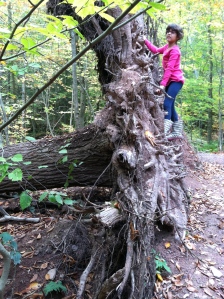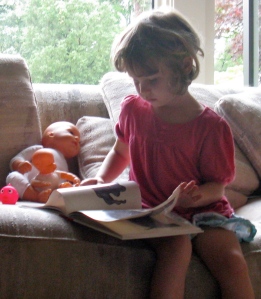(CHILDREN’S BOOKS, LANDSCAPE & PLAY)
At an alumni event a couple weeks ago at the Design School at Penn, a landscape architect I’d recently met asked for an elevator speech on my career and interests. I gave it my best shot, but thankfully we got interrupted before I could finish — about 4 minutes into what was no doubt a much longer ride than he had bargained for.
I’ve always maintained that there are threads that link my work as a writer, landscape architect, play advocate, teacher, naturalist-wannabe, mother, etc. But I’m never able to articulate exactly what the connections are, beyond offering that a focus on children runs through them all. Sometimes I float phrases like “a lot of my stories derive from natural phenomena” or “my writing tends to have a really strong sense of place” — both feeble attempts at articulating a connection that I know is there.
A couple days after that meandering elevator speech, I came across an Adam Gopnik piece I’d torn from a New Yorker many, many years ago. About children’s books, Gopnik says “What children need is an education in the possible….. Children know perfectly well who they are; all experience conspires to tell them that. What they would like to know is who they may yet be, and what boat they have to take to get there.”
His words reminded me of an argument for the importance of play, and particularly dramatic play, which had always resonated with me. Play theorist Brian Sutton-Smith has this idea that imaginative play involves an exploration of possibilities and that, in Sutton-Smith’s words, ‘‘The adaptive advantage [from an evolutionary perspective] has often gone to those who ventured upon their possibility with cries of exultant commitment…. What is adaptive about play, therefore, may be not only the skills that are a part of it but also the willful belief in acting out one’s own capacity for the future.’’
This idea that play and story both help children to imagine futures — and moreover to envision their own agency in shaping those futures — is so powerful. Play and books (and life experiences, too) give kids the real, intellectual and emotional space to explore and test the possible. In an interview with KidsReads, Kate DiCamillo says of writing children’s books, “I love that books for kids allow for magic and demand hope…” Reading, writing and play: hope undergirds all of them.
Ok, so there it is: my functional and philosophical link between play and children’s literature. Phew. Now, what about landscape?
Conversations about play and landscape have followed a few overlapping tracks in the US’s popular media lately:
Much is written about how unstructured play has been squeezed from the lives of modern children. At one end of the socio-economic spectrum, parents hover, filling their children’s days with extracurriculars, enrichment classes, and infinite other structured, adult-driven activities. At all income levels, electronics and screens now dominate what little free time chidlren do have.
Accompanying and contributing to these trends is our cultural obsession with danger. We are sold everything under the sun by having various fears tapped into and, because in the US we are so prone to suing, our cities and towns and suburbs are plagued with uninspired and unintegrated straight-from-the-catalog play structures. Within the design world, there is a great push for a move away from the monotony of safety-focussed, catalog-purchased playstructures and towards unique designs that engage kids (Paige Johnson’s play-scapes blog is a great voice in the push for good design in outdoor play spaces).
Adventure play and adventure playgrounds — which originated in Europe mid-century and incorporate “loose parts”, lots of mess, and relatively hands-off supervision by trained “play workers”, are also on the table as places where children can better learn to negotiate danger and experiment with less prescribed physical, material and social worlds (see this recent article in The Atlantic).
Finally the Nature Play movement, which gained much traction after the 2005 publication of Richard Louv’s Last Child In the Woods, has focussed specifically on unstructured play in nature, and on the degree to which modern children in developed countries are increasingly deprived of unsupervised time in wild or natural or green spaces.
Why does free time outdoors in ‘natural’ or ‘wild’ spaces matter? There are developmental arguments about the unique sensory stimulation and engagement that nature offers, and about fostering independence, and about learning to negotiate risk. And then there is an argument about love. Environmental Psychologist Louise Chawla has studied and written extensively about the factors that lead people to develop a strong environmental commitment and sense of efficacy. Her research subjects, who were all evnironmentally committed and active, first developed their attachment to the natural world in childhood. And they developed this connection through free, unstructured time spent outdoors.
Children learn to love the natural world by being in it: playing, exploring, planting, picking, making and messing around. Stuff them full of all the facts you want about melting icebergs and dwindling populations of sea turtles; it won’t matter if they haven’t first developed a personal and hands-on affinity.
Chawla identified a second key factor in her subjects’ development as well: a childhood relationship with an adult who demonstates and shares a similar affinity for the natural world. This person is usually a family member or sometimes a teacher. In any case, he or she is understood more as mentor or guide than as imparter-of-knowledge. Which, at their best, all teachers should be.
A sharing and transmittal of this Rachel Carson-esque sense of wonder — somehow pure and elemental — carries real urgency, now, as ongoing population growth continues to bring rapid change to the natural world and our realtionship with it, and continuing urbanization increasingly distances people from un-cultivated and first-hand engagement with nature’s cycles and permutations.
The Sense of Wonder brings me back to children’s books. A couple years ago author Micheal Chabon wrote about what he called “The Wilderness of Childhood“, and got at the question of landscape in relation to books. “Most great stories of adventure,” he wrote, “from The Hobbit to Seven Pillars of Wisdom, come furnished with a map. That’s because every story of adventure is in part the story of a landscape, of the interrelationship between human beings (or Hobbits, as the case may be) and topography. Every adventure story is conceivable only with reference to the particular set of geographical features that in each case sets the course, literally, of the tale…..”
Chabon goes on,”The thing that strikes me now when I think about the Wilderness of Childhood is the incredible degree of freedom my parents gave me to adventure there. …. What is the impact of the closing down of the Wilderness on the development of children’s imaginations?…. Art is a form of exploration, of sailing off into the unknown alone, heading for those unmarked places on the map. If children are not permitted—not taught—to be adventurers and explorers as children, what will become of the world of adventure, of stories, of literature itself?”
So there it is, full circle: from children’s books to play to landscape and back to children’s books. Landscapes (real and fictional) and play within them (actual and imagined) are important, essential parts of childhood. And they are key ingredients in raising children who love their worlds (natural and otherwise) and feel empowered to act in and take care of them. It’s pretty basic and important stuff.
Meanwhile, my new, improved and concise elevator speech remains a work in progress. (I clearly have a ways to go on the ‘concise’ part.)



This makes me think about Adventure Playgrounds. There are 1000 of them in Europe. We have two. I found a cool web site about them: http://adventureplaygrounds.hampshire.edu/index.html
It all comes down to storytelling, doesn’t it? As I’m learning to organize our big new garden, it feels like making up stories: here is the path cats take through the lilacs. Turn this corner and discover raspberries. Here is an opening that looks like a door…wonder what’s on the other side? etc.!
I spent a part of my morning talking to a group of 6th graders about the history of playgrounds in the US. Would that Adventure Playgrounds were a bigger part of that history. And yes, it does all come down to stories/narratives. My very first project in LA grad school was a path project where we were asked to understand the path as a choreography, narrative, etc.
This post made me think of A.S. Byatt’s novel, The Children’s Book, which I loved. Another look at nature, imaginative play, and a child’s exploration of the possible.
I will add it to the summer reading list pile — thanks for the recommendation (and for reading)! On another note: what comes to mind, for you, when you hear the words “Tall Tale”?